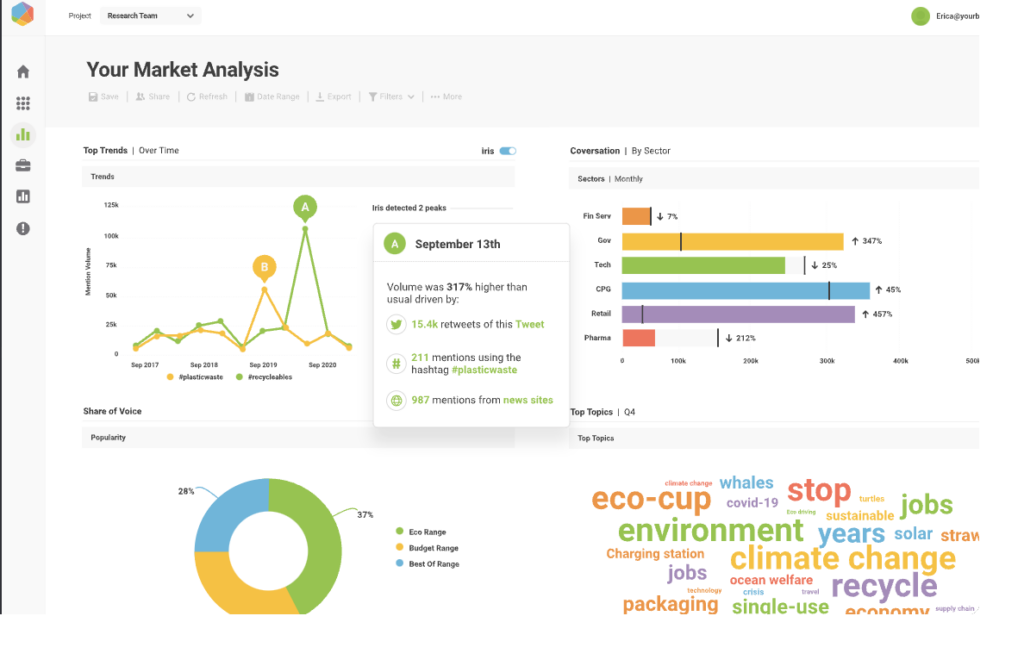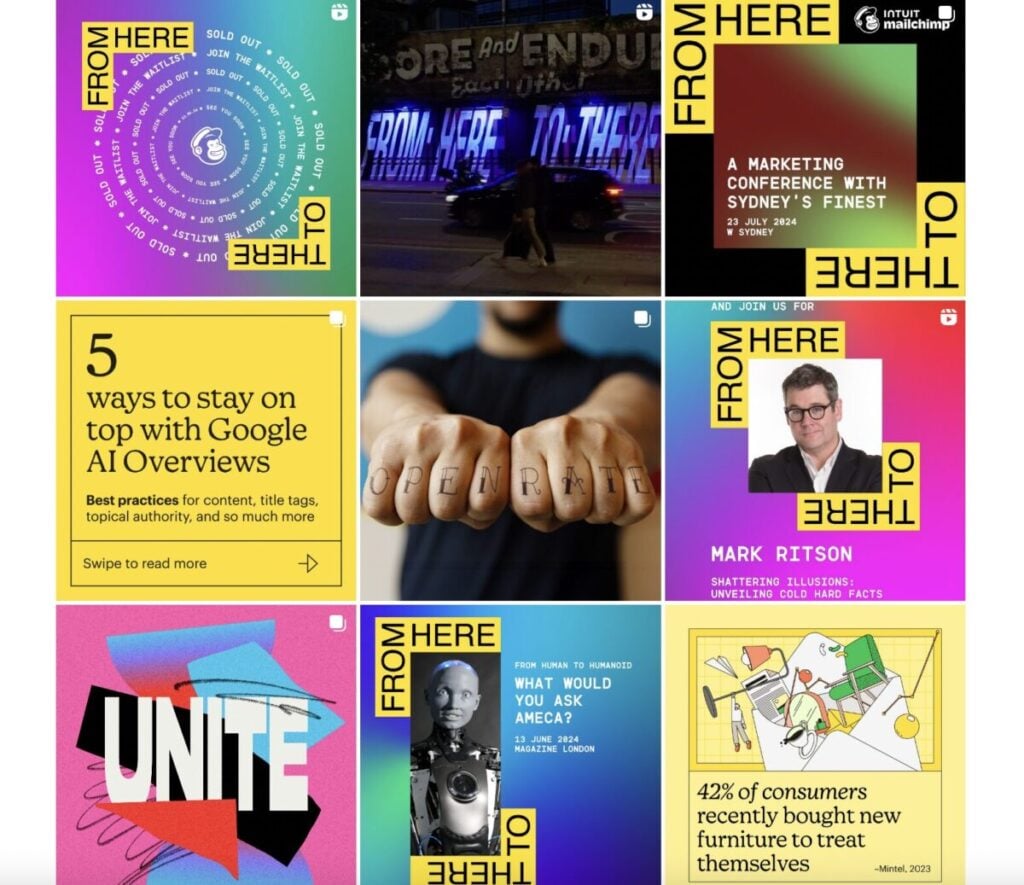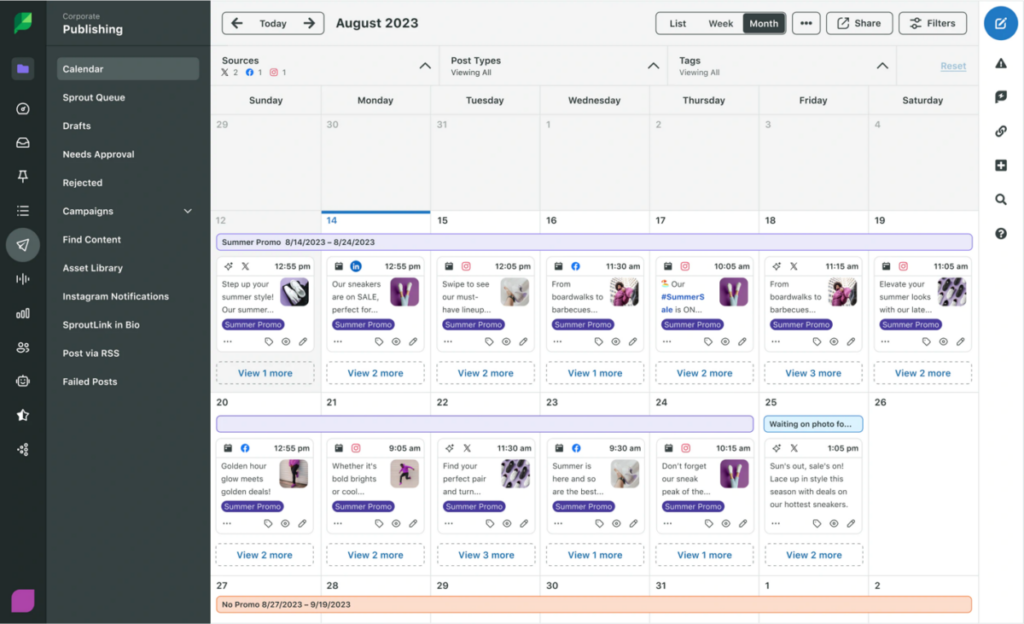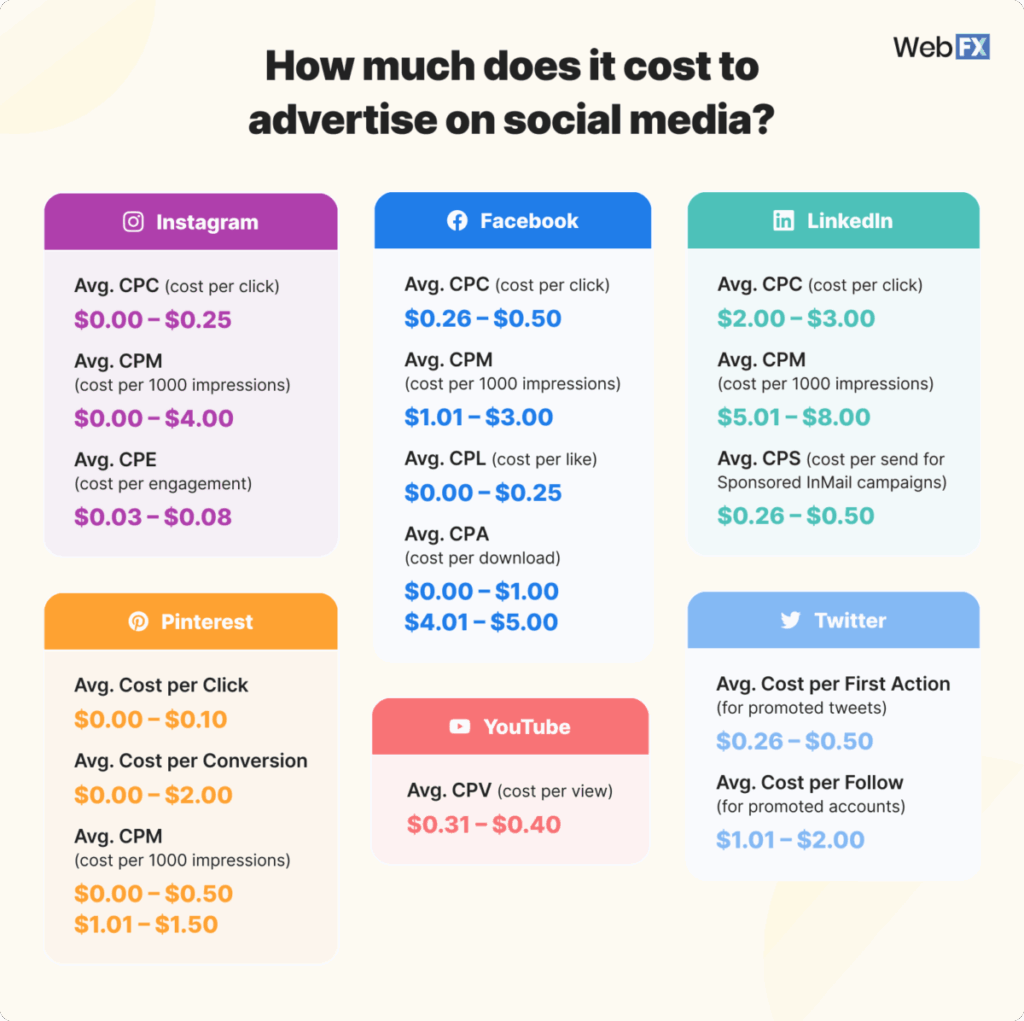Having a solid social media marketing plan helps you organize your efforts and streamline your resources towards specific marketing tactics. As such, it enables you to get more out of social media and ensure that you accomplish your goals. However, creating one from scratch may be a challenge if you haven’t done one before. This post serves as a guide to help you through the process so you can learn how to create a social media marketing plan from scratch.
What is a Social Media Marketing Plan
A social media marketing plan is a strategic framework that outlines how a business will utilize social media platforms to achieve specific marketing objectives, such as increasing brand awareness, generating leads, or driving website traffic. For example, Wendy's has effectively used its social media marketing plan by engaging with its audience through humorous and witty interactions on Twitter, which has significantly boosted its brand visibility and customer engagement. 73% of marketers believe that their efforts through social media marketing have been "somewhat effective" or "very effective" for their business, highlighting the importance of a well-structured plan in achieving marketing success.
1. Set Your Goals
All effective social media strategies have one thing in common: they have clearly defined goals. Before you start working on your strategy, you need to figure out what is it that you want to achieve.
Maybe your focus is to improve your brand awareness. Or perhaps to boost your engagement and follower count. Whatever your goals are, write them down. Break these final goals into smaller parts so that they are attainable as well as realistic.
Your goals will affect other parts of your social media marketing strategy from your budget to the social media platforms you use. It will also influence decisions such as which tactics to use, whether to invest in paid ads, and so on. For example, if your goal is to drive sales, you may choose to use Instagram Shopping features and promote your shoppable posts through Instagram ads.
In the case of The NOBO, their Instagram ads made use of carousel posts featuring specific products. The caption included a promo code to encourage the target audience to make a purchase. This type of ad campaign would help to achieve the goal of driving brand awareness and boosting sales.

Once you’ve finalized your goals, you can also identify the key metrics that you’ll use later on to measure the impact of your social media efforts. These metrics should be relevant to your goals so you can clearly see how your plan is impacting specific social media performance. This will help you streamline campaign measurement as you’re tracking specific KPIs instead of monitoring each and every metric.
2. Research Your Target Audience
As a marketer, it’s crucial to understand what your target audience’s preferences are. To develop an effective social media marketing plan, you should have answers to the following questions:
- Which social media platform is your target audience most active on?
- What kind of content do they like on social media?
- What are their pain points?
- In which ways do they engage with brands on social media?
In addition to this, it’s also advisable to build a target persona for your brand. You should take into consideration factors like age, gender, lifestyle, and interests.
Based on these factors, you’ll have to decide which social media channel is the best for your brand and what kind of content will work for you. So, if your brand’s target audience is mainly teenagers who love gaming, you may want to focus on Twitch. Even though Facebook and Instagram are more mainstream, Twitch is where your target audience is likely to spend most of their time.
Here’s the bottom line: You need to align your social media and content strategies to match with your audience’s preferences.
If you’re starting from scratch, you may not have enough audience insights on the native analytics dashboard of your social media channels. Make use of third-party audience research software to uncover practical insights about your target audience. Platforms like Brandwatch can provide you with in-depth market insights so you can gain a better understanding of your audience and the conversations that matter.

Source: brandwatch.com
To get a deeper understanding of how to appeal to your target audience, go beyond quantitative insights. Look for qualitative information using social listening to get a better idea of the conversations they’re engaging in, the issues they’re expressing, and the solutions they’re looking for.
This will help you stay on top of trending topics and identify ways to better resonate with your audience. Your social listening efforts will also inform your content strategy later on. It will show you the types of topics to create content about and the hashtags to include for increased visibility. Moreover, you can even use it to identify selling opportunities and customer care opportunities as well as potential PR disasters that need immediate attention.
3. Find Your Brand Personality
Each brand has its own personality, so called brand identity. It’s defined by the way a brand communicates with their customers. The tone that a brand uses to express themselves determines what kind of personality the brand has. It can make a lot of difference in shaping public perception.
Your social media marketing efforts should emulate this brand personality so that people can associate it with who you are as a brand. This will help you build a connection with them as it’s much easier for consumers to feel connected to brands with a relatable personality rather than one that seems cold and inaccessible.
The key to finding your brand voice and personality is to understand your target audience. You need to communicate in a way that they can relate to.
So, if your audience consists of mainly millennials, you could experiment with funny memes and emojis as a part of your content strategy. On the other hand, if your audience is mainly business moguls, it’s advisable for you to use a tone that is more sophisticated and professional.
Take a leaf from Old Spice’s brand personality notebook. Their target audience is mainly young men. So, they’ve kept their brand voice casual. Occasionally, they even add some humour in their posts. Because of this, their content resonates with their audience.
Also, keep in mind that your brand personality needs to be consistent across all social media channels. So, if you have multiple people handling different pages, it’s necessary for you to get them on the same page.
From your comments to your status updates, everything needs to use the same brand voice. One of the best ways to ensure consistency is to write a style guide that clearly explains your brand voice and tone. Make sure your social media style guide includes essential information about consistency and language rules as well as how to handle audience interactions.
4. Develop a Visual Identity
Most social media platforms are strong on visuals. As such, they give you the perfect opportunity to showcase your brand’s visual identity. A visual identity is the visual elements that you want people to associate with your brand. It can include logos, colors, design elements, fonts, and editing styles.
A strong visual identity enables your target audience to immediately recognize content from your brand. It also helps you maintain a cohesive visual feed that looks professional and pleasing to the eye. So it should be showcased consistently in all your profiles and content across all your social media channels. In other words, make sure you’re portraying the visual identity in your profile pictures and cover photos as well as your original graphics and promotional photos.
For instance, Intuit Mailchimp regularly publishes original graphics to share information about datapoints, events, and tips. The brand’s signature yellow features prominently across these graphics. You can also see the brand using the same set of fonts in all these graphics and promotional materials.

Source: instagram.com
The style guide mentioned earlier should contain instructions that your designers, video producers, and editors should follow when developing your social media content. Make sure everyone is on board about what color schemes and tones they should use when designing or editing visual material. Choose a specific set of fonts to use and specify when they should be used.
That way, even if multiple people are creating content for your social media, everything remains cohesive. This is particularly important if you’re working with freelancers and fractional teams to outsource social media content creation.
5. Find Out What Works for Your Competitors
The best way to avoid common mistakes in your social media marketing strategy is to learn from your competitors’ mistakes. Conduct a social media competitor analysis to give you an idea of the kind of content that works well. This involves scouring through your competitors’ social media pages to see what types of content they’re posting, how often they’re posting, how they’re interacting with their audience, and more.
The idea here isn’t to copy the same for your brand. Instead, get inspiration from them and create your own social media campaigns to match your brand personality accordingly. Looking at your competitors’ campaigns will help you refine your strategy.
You may even decide to take a totally different approach. That’s okay, too. Even in the same industry, totally different strategies can work for different brands.
In fact, Rolex and Daniel Wellington both sell watches. However, their social media strategies are completely different. Take a look at the screenshot below. Just like in the picture, most of the photos on Rolex’s Instagram page showcase their watches. Their captions detail the features of the watch.
In contrast, Daniel Wellington takes a very different approach. Their Instagram feed features user-generated content, influencer-generated content, and in-house promotional content.
That’s not to say that one of them is better than the other. But it should be noted that each brand has set themselves apart from their competitors in their own way.
Rolex’s social media marketing efforts stay true to the brand’s personality of sophistication and reliability. Meanwhile, Daniel Wellington tries to maintain a brand personality that’s more relatable and accessible to the general public, which shows in the way they make use of content generated by influencers and customers.
Pay close attention to the comments on your competitors’ social media posts as well as the brand mentions involving them. This will give you an idea of what people are saying about them so you can identify what people love about the brand or what they’re complaining about. Use these insights to inform your own approach. You can take advantage of untapped opportunities, avoid vital mistakes, and improve on tactics that are working well for them.
6. Create Engaging Content
Content is at the center of any social media strategy. Before you start working on your content, you should have a good idea of your brand personality, goals, and your target audience’s preferences.
Even though you’ve done all the groundwork, content creation may seem a little overwhelming. After all, there is a lot of cover. You can’t be too promotional or you may risk annoying your audience. So, then what can you do?
The best thing to do is diversify your social media content. Post different types of content to keep things fresh and entertaining for your audience while balancing it out with promotional and informative content.
Here are a few ideas for your content strategy:
- Live Videos
- Conduct Polls
- Social Media Takeovers
- Memes
- AMA sessions
- “Behind-the-Scenes” Videos and Photos
- User-Generated Content
- Influencer-Generated Content
- Infographics
- GIFs
- Podcasts
- Interviews
You can also check out our list of social media post ideas for a more in-depth look at some of these options.
Many content creators struggle with finding or creating new content to post. There is a clever way of solving this issue. You can repurpose your old content into a new format. For instance, you can create a video or a podcast from a blog post. Or you could create an infographic from a statistic that you’ve quoted in your blog post.
Another way of creating more content for social media easily is to build content themes. This approach works well with Instagram and other visual platforms.
This involves uploading a series of posts based on a specific theme such as a topic or a color. For instance, you may do one week of posts around your latest product and another week of posts related to an ongoing trend. Or you may even choose specific colors and publish content featuring the color of the week.
Profitec, a company that produces espresso machines, uses this strategy for their Instagram feed. Their posts are either color-coded or are uploaded in a collage-like manner to create a visually appealing feed.

Source: instagram.com
Don’t forget to make use of the latest trends to inspire your social media content strategy. You could create content related to viral memes and topics or Reels and TikTok videos using trending sounds and music. Alternatively, you could create content related to conversations and events that are trending right now.
Duolingo nails this on TikTok with unhinged and hilarious videos that are on-trend with the latest topics and viral memes. The brand manages to stay in the conversation with creative TikToks that cover everything from the F1 races to the “looking for a man in finance” viral trend.
@duolingo hot owl summer loading… #finance #songofthesummer ♬ Looking for a man tima remix - Tima Pages
7. Create a Posting Schedule
When it comes to your social media marketing strategy, posting consistently is key. Of course, it’s not easy, but you’ll have to be disciplined.
Ranking algorithms favor frequent posting on social media, so you’re likely to get more visibility by publishing posts more often. At the same time, it tells your customers that you are active and approachable on social media.
You can also use various social media scheduling tools to maintain a consistent social media schedule. This will help you save time by planning your content ahead of time. You’ll be able to keep up with your publishing schedule and minimize the risk of forgetting a post or missing an important event.

Source: sproutsocial.com
Before you schedule your posts, check out the best time to post for the social media network that you’ve chosen. That way, you can ensure that your scheduled posts go out at times when your audience is most active and, therefore, most likely to engage. So you can boost engagements, which will subsequently improve your post visibility.
Keep in mind that the optimal post time for your business may vary based on your location and audience. Look into the most active times shown on your native analytics dashboard to get an idea of when to post. Some social media scheduling tools will even provide you with best time to post recommendations based on the engagements received when your scheduled posts go live.
Besides post timing, frequency is another important factor to consider in your social media marketing plan. Should you post every day or even multiple times a day? Or should you stick to the Stories format for everyday engagement while saving your in-feed posts for something more “official”? The answer largely depends on your brand, industry, and social media platform.
Experiment with various posting frequencies to find the right balance for your brand. See how your engagement rises or drops based on the number of posts you share in a day across various social media channels. This will help you come up with a solid publishing schedule that your team can follow when strategizing and producing content for social media.
There are plenty of social media content calendar tools that you can use to plan your content. These will help you outline what and when to post across various social networks. You can even work collaboratively with team members to ensure that posts are reviewed and approved by relevant personnel before they go live.

Source: loomly.com
When you have a content calendar in place, you can easily keep track of what you need to post. However, it’s easy to run out of ideas when you’re constantly creating hundreds of posts a month. Check out our extensive list of content ideas to fill up your publishing schedule.
8. Promote Your Content
If you want your content to reach a broad audience, you need to promote it well. While it’s best to get organic traffic, you may have to rely on paid social media ads initially to gain some traction. It can help you gain more visibility quickly.
Depending on the social media platform of your choice, your budget, and your industry, the cost may vary. But one thing is common across platforms: social media ads are expensive.
According to a WebFX survey, the cost per action on Facebook ads range between $0.26 and $8 while Instagram ads cost between $0 and $5 per action. Meanwhile, LinkedIn ads will cost you at least $2 per click or $5 per impression.

To keep your costs low, you need to make sure that you’re using the right targeting efforts to reach a highly relevant audience. Additionally, your ads should be relevant and impactful, promoting the right products and offers at the right time. Make use of the advertising tools available on different social networks to optimize the performance of your ads.
Here are a few tricks you can follow to reduce the cost of your social media ads:
- Post high-quality content which is relevant to your brand and niche. Facebook gives you a “relevance score” which impacts how your ads perform.
- You should cap your bids. Don’t set a daily budget for Instagram and Facebook.
- On Twitter, start slow by bidding manually. As you gain more traffic, raise your bid.
- On LinkedIn ads, select the “Matched Audience” option to boost your ROI. It sends your ads to a highly-targeted audience who are likely to convert.
9. Evaluate Your Campaign Performance
Developing an effective social media marketing plan takes time. You may make a lot of mistakes on the way. If you are continuously analyzing your campaign, you can reduce the number of mistakes you make.
Identify the posts that get the most traffic and see which ones didn’t perform well. Based on that, make changes to your social media strategy. All social media platforms provide you with detailed insights into how your posts and ads are performing. These insights will inform you about the types of posts that resonate with your audience and the ads that are driving conversions.
See what your top-performing posts and ads have in common so you can replicate them for an optimized social media marketing plan. You can also keep track of your low-performing posts to identify patterns and learn from your mistakes. That way, you can avoid wasting your time and resources on posts or ads with a low impact.
You can also use Google Analytics to evaluate your campaign performance in relation to your website performance. See how different channels and posts are driving traffic to your website. Monitor how those visitors are engaging with your pages and how those visits are turning into action.
Social Media Marketing Strategy Template
To assist in developing a comprehensive social media marketing plan, you can utilize the template we created. This template provides a structured approach, guiding you through key components such as defining your objectives, selecting the right platforms, and creating a content calendar. By following this template, you can streamline your social media strategy and enhance your marketing efforts effectively.
Social Media Strategy Template
Plan for Social Media Success
With a social media marketing plan in place, you can take a strategic approach to effectively reach and engage your target audience. Use this guide to start from scratch and create a successful social media marketing plan.
Frequently Asked Questions
How do I write a social media marketing plan?
You can write a social media plan by documenting your social media goals and ideal customer persona as well as your brand personality and visual identity. Then come up with a content strategy with content ideas, publishing frequency, and post timings, and document it in your social media content calendar.
What is the 6-step process for a social media marketing plan?
The 6-step process for a social media marketing plan involves:
- Researching and listening
- Goal identification
- Audience identification
- Content strategy development
- Content production
- Performance tracking
How do I start social media marketing?
You can start social media marketing by identifying your goals and researching your audience. Then develop a strategy to publish the right types of content at the right time.
How to run a social media page?
Running a social media page involves posting high-quality content consistently and engaging with your audience by responding to their comments and answering their questions.
What are the three C’s of social media marketing?
The three C’s of social media marketing are content, community, and conversion.
![Preview for How to Create a Social Media Marketing Plan from Scratch [Template]](https://influencermarketinghub.com/imaginary/resize?width=414&type=webp&url=https://influencermarketinghub.com/wp-content/uploads/2019/10/image-1-2.png)


